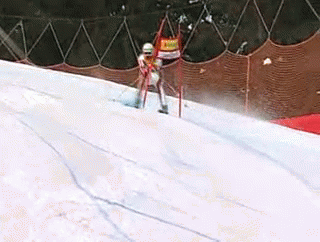Paul Berens
Life Imitates Skiing
After indulging in some Beijing Olympics on the YouTube, I’m inspired to rap about alpine skiing as one who got to take it up from an early age and then eventually dabble in some slalom ski racing.
So before the world stops thinking about these niche sports practiced by cold-weather nutters, here’s some basic ski racing wisdom whose applicability to real life is worth pondering:
- Anticipate. One eye on the present; the other on the future. In a slalom course that means constantly glancing ahead two or three gates: skiing's version of "skate to where the puck will be" (as opposed to where it is presently). You're aware of your present reality, but always with an eye toward what's coming.

Run to meet the future...or it may give the boys a beating.
- Balance. Your stance, and how and when weight is transferred between skis is how one deals with unforeseen shifts in terrain. There was a great Norwegian alpine ski racer named Stein Eriksen who was skiing's "first superstar": his skiing prowess was matched or exceeded by his dashing looks and charm. But the fella skied like this:
 ...which everyone thought was pretty nifty at the time (1950s). (I confess: I went through my own rudderless phase of pressing skis together during my childhood [post-1950s].) It turns out this hip technique is passable if you're on a Blue Square groomer on a sunny 3°C day, but a recipe for disaster if you're flying down a slope you think is comprised of soft, new snow, but lurking underneath lies a layer of ice ready to dump someone skiing like this (because you're essentially totally off-balance). There's a strategic flexibility / scenario-planning analogy and life lesson in there somewhere: "hope for the best, plan for the worst"? So...better go get that life insurance policy like you've been meaning to.
...which everyone thought was pretty nifty at the time (1950s). (I confess: I went through my own rudderless phase of pressing skis together during my childhood [post-1950s].) It turns out this hip technique is passable if you're on a Blue Square groomer on a sunny 3°C day, but a recipe for disaster if you're flying down a slope you think is comprised of soft, new snow, but lurking underneath lies a layer of ice ready to dump someone skiing like this (because you're essentially totally off-balance). There's a strategic flexibility / scenario-planning analogy and life lesson in there somewhere: "hope for the best, plan for the worst"? So...better go get that life insurance policy like you've been meaning to.
- Commit. An economical form of Just Do It. Any ski instructor will affirm the importance of pointing one's skis down the hill and leaning into it (a.k.a. "committing"). When you're learning to ski it feels strange and scary—like I'm going to tumble forward to my doom—but weirdly the physics are such that it's far easier to control your skis (initiate and complete a proper turn) when you're on the balls of your feet and heading directly down the fall line. The inverse is true, too: if/when you freak out and pull away or lean back, it becomes increasingly difficult to get the skis to go where you want them to go when you want. The same idea is true in a lot of sports:
The life analogy: sometimes you can't pussyfoot around.
That’s what I’ve got thus far. If you think of others, keep the conversation going with #LifeImitatesSkiing.
— ᴘ. ᴍ. ʙ.
First published: 2022-02-19 | tweet | cast | subscribe
personal development

